![]()
![]()
![]()
Use LEFT and RIGHT arrow keys to navigate between flashcards;
Use UP and DOWN arrow keys to flip the card;
H to show hint;
A reads text to speech;
167 Cards in this Set
- Front
- Back
- 3rd side (hint)
|
Innermost to outermost layers of the heart wall... |
Endocardium Myocardium Epicardium |
|
|
|
Name the two protein filaments responsible for the striation formation of cardiac muscle. |
Actin Myosin |
|
|
|
What types of cell junctions does cardiac muscle have? |
Gap junctions Desmosomes |
|
|
|
____________ link cardiac muscle cells mechanically. |
Desmosomes |
|
|
|
____________ link cardiac muscle cells electrically. |
Gap junctions |
|
|
|
The heart's many cells work together and act as one big cell. This is known as a ______________. |
Functional Syncytium |
|
|
|
Which electrical event proceeds muscle cell contraction? |
Depolarization |
|
|
|
Which type of junction coordinates depolarization and contraction? |
Gap junctions |
|
|
|
Responsible for all-or-none of the heart... |
Gap junctions |
|
|
|
Name five important features of cardiac muscle. |
Striated Nucleated Contractility Branched Have Intercalated disks |
|
|
|
Vessels that carry deoxygenated blood into the heart... |
Superior vena cava Inferior vena cava Coronary sinus |
|
|
|
Function of the right auricle... |
Gives the right atrium some expandability |
|
|
|
The ridges of muscle underneath the right auricle... |
Pectinate Muscles |
|
|
|
Receiving chambers of the heart... |
Right and Left Atria |
|
|
|
The R. Atrium receives _________ blood from the _________ circuit. |
Deoxygenated Systemic |
|
|
|
The L. Atrium receives ________ blood from the ________ circuit. |
Oxygenated Pulmonary |
|
|
|
Depression in the interatrial septum... |
Fossa ovalis |
|
|
|
The two atria are separated by... |
Interatrial septum |
|
|
|
The auricles' ability to stretch and expand allow the atria to... |
Accept a greater volume of blood |
|
|
|
What are the muscular pumping chambers of the heart? |
Right and Left Ventricles |
|
|
|
The R. Ventricle pumps ________ blood into the ________ circuit. |
Deoxygenated Pulmonary |
|
|
|
The L. Ventricle pumps _________ blood into the ________ circuit. |
Oxygenated Systemic |
|
|
|
Three blood vessels that empty into the R. Atrium... |
Superior vena cava Inferior vena cava Coronary sinus |
|
|
|
The superior vena cava delivers deoxygenated blood from areas above the __________. |
Diaphragm |
|
|
|
The inferior vena cava delivers deoxygenated blood from areas _________ the diaphragm. |
Below |
|
|
|
The coronary sinus supplies blood to the _____________. |
Heart wall |
|
|
|
The coronary sinus delivers deoxygenated blood from the _____________. |
Coronary circuit |
|
|
|
At this location in the fetal heart, there is an opening between the atria... |
Foramen ovale |
|
|
|
In a fetus, gas exchange occurs across the ____________. |
Placenta |
|
|
|
In a fetus, the foramen ovale allows blood to _________ the pulmonary vessels. |
Bypass |
|
|
|
Preventing blood flow from the R. Ventricle to the R. Atrium is the ___________. |
Tricuspid valve |
|
|
|
Attaches the tricuspid valve and papillary muscles.... |
Chordae tendineae |
|
|
|
The chordae tendinae and contraction of papillary muscles prevent ______________. |
The backflow of blood into the Atrium |
|
|
|
Visible in the anterior wall of the right ventricle are ridges of muscle known as ____________. |
Trabeculae carnae |
|
|
|
Prevents the backflow of blood from the pulmonary trunk to the right ventricle... |
Pulmonary semi-lunar valve |
|
|
|
Blood from the R. Ventricle exits through the ___________ and into the __________. |
Pulmonary semi-lunar valve Pulmonary trunk |
|
|
|
The pulmonary trunk branches into the ______________. |
The left and right pulmonary arteries |
|
|
|
The L. and R. Pulmonary arteries carry ____________ blood to the ___________. |
Deoxygenated Left and right lungs |
|
|
|
_____________ carry oxygenated blood from the lungs to the ____________. |
Pulmonary veins L. Atrium |
|
|
|
The fossa ovalis is located in the ... |
Interatrial septum |
|
|
|
Blood flows from the L. Atrium to the L. Ventricle through the... |
Bicuspid or mitral valve |
|
|
|
Do both ventricles eject the same amount of blood? |
Yes |
|
|
|
Which ventricle is a larger and stronger pump? |
Left ventricle |
|
|
|
Blood leaving the L. Ventricle through the ________ enters the _________. |
Aortic semi-lunar valve Aorta |
|
|
|
Three branches extending from the aortic arch... |
Brachiocephalic artery L. Common carotid Artery L. Subclavian Artery |
|
|
|
The brachiocephalic artery supplies blood to the... |
Right head and neck. |
|
|
|
The Left common carotid artery supplies blood to the... |
Left neck and head |
|
|
|
The Left Common Carotid Artery supplies the ... |
Left head and neck |
|
|
|
The Left subclavian Artery supplies blood to the... |
Left shoulder and arm |
|
|
|
The Aortic arch is connected to the pulmonary trunk by the ... |
Ligamentum arteriosum |
|
|
|
The ligamentum arteriosum is a remnant of the ___________, which provided a bypass to the pulmonary circuit. |
Ductus arteriosus |
|
|
|
Two arteries that come from the ascending aorta... |
Left and Right Coronary Arteries |
|
|
|
Ridges of muscle on ventricle walls... |
Trabeculae carneae |
|
|
|
Exiting the R. Ventricle is the... |
Pulmonary trunk |
|
|
|
Located at the beginning of the pulmonary trunk... |
Pulmonary semi-lunar valve |
|
|
|
Prevents backflow from the pulmonary trunk to the R. Ventricle. |
Pulmonary semi-lunar valve |
|
|
|
The pulmonary trunk branches into the... |
Right and Left pulmonary arteries |
|
|
|
Which vessels carry deoxygenated blood to the lungs? |
Right and Left pulmonary arteries |
|
|
|
Oxygenated blood returns to the L. Atrium via the four... |
Pulmonary veins |
|
|
|
Backflow from the L. Ventricle to the L. Atrium is prevented by the... |
Bicuspid or mitral valve |
|
|
|
Which side of the ❤️ works against a greater resistance? |
The left side |
|
|
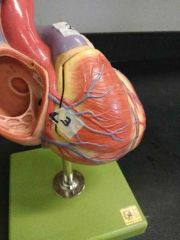
Identify #3. |
R. Coronary Artery |
|
|
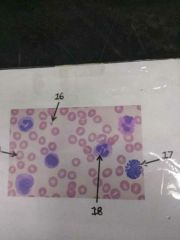
Function of #17 |
Releases histamine + heparin during inflammation |
|
|
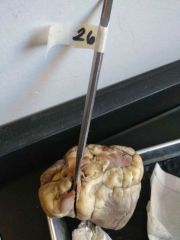
Identify #26 |
Pulmonary trunk |
|
|

Identify #27 |
Brachiocephalic artery |
|
|
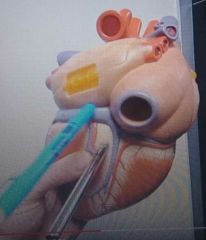
What vessel is the marker touching? |
Coronary Sinus |
|
|
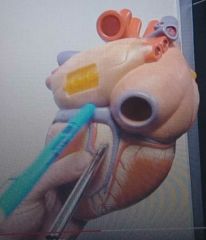
What is the function of this vessel? |
Drains the blood from the heart wall |
|
|
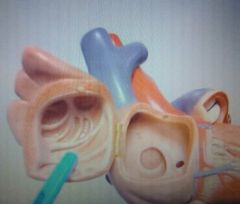
What are these? |
Pectinate muscles |
|
|
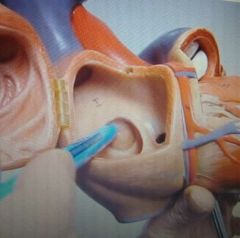
What is this structure? |
Fossa ovalis |
|
|
|
The fossa ovalis is a remnant of a fetal heart structure called... |
Foramen ovale |
|
|
|
The R. Ventricle is the pumping chamber for _________ blood. |
Deoxygenated |
|
|
|
Which chamber moves blood into the lungs? |
R. Ventricle |
|
|
|
Bulges of muscle that attaches to the chordae tendinae... |
Papillary muscles |
|
|
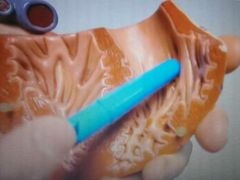
This is... |
Trabeculae Carneae |
|
|

What is this vessel? |
Pulmonary Trunk |
|
|
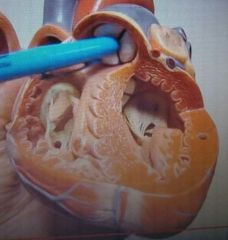
Which valve? |
Pulmonary semi-lunar valve |
|
|
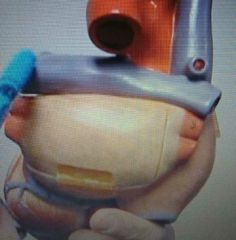
What are these vessels? |
Pulmonary arteries |
|
|
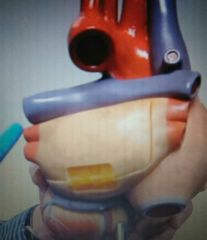
What are these vessels called? |
Pulmonary veins (4) |
|
|
|
Pulmonary arteries take _________ blood to the _________. |
Deoxygenated Lungs |
|
|
|
Pulmonary veins bring __________ blood _______ the ________ to the heart. |
Oxygenated From Lungs |
|
|
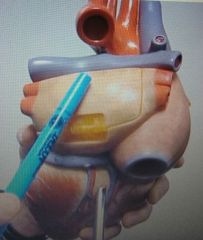
Which chamber is this? |
L. Atrium |
|
|
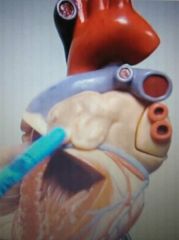
Name this structure. |
L. Auricle |
|
|

Which valve? |
Bicuspid/Mitral Valve |
|
|
|
The L. Ventricle pumps more blood than the R. Ventricle. True or False and why. |
False. They pump the same amount of blood. |
|
|
|
From the L. Ventricle blood goes upward into the... |
Aorta |
|
|
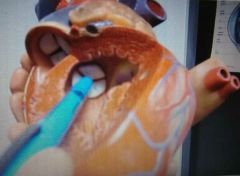
Structure? |
Aortic semi-lunar valve |
|
|
|
When the L. Ventricle squeezes, it forces the bicuspid valve to... |
Close |
|
|
|
_________ and _________ prevent the Tricuspid and Bicuspid valves from prolapse. |
Chordae tendinae Papillary muscles |
|
|
|
What makes the "lub" sound in the heart? |
The Tricuspid and Bicuspid/Mitral Valves closing |
|
|
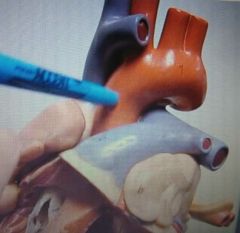
What is this? |
Ascending aorta |
|
|
|
When blood from the aorta tries to flow backward, it will close the... |
Aortic semi-lunar valve |
|
|
|
What creates the "dub" sound in the heart? |
The semi-lunar valves closing |
|
|

Name this vessel. |
R. Coronary Artery |
|
|

This is the... |
Aortic arch |
|
|
|
Three major branches off the Aortic Arch... |
Brachiocephalic artery Left Common Carotid artery Left Subclavian artery |
|
|

Name and function. |
Left Subclavian artery Supplies the left shoulder and left arm. |
|
|
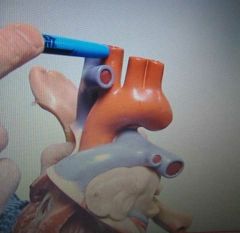
Name and function. |
Brachiocephalic artery Supplies the right neck and head. |
|
|
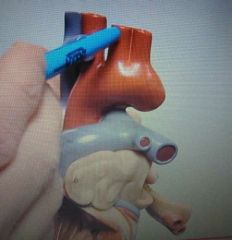
Name and function. |
Left Common Carotid Artery Supplies the Left neck and Left head. |
|
|
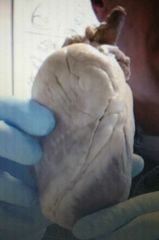
Anterior or Posterior sheep heart? Name the diagonal line. |
Anterior Anterior interventricular sulcus |
|
|
|
What marks the division between the left and right ventricles of the front of the sheep's heart? |
Anterior Interventricular sulcus |
|
|
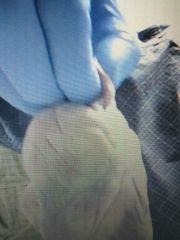
This vessel being held in the anterior sheep's heart is... |
Pulmonary trunk |
|
|
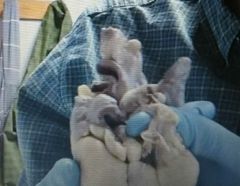
Which vessels are my finger going through? |
Superior vena cava Inferior vena cava |
|
|
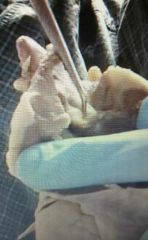
This flap at the base of the pulmonary trunk is the... |
Pulmonary semi-lunar valve |
|
|

Which ventricle is this? Which structure do you see that is located only in this ventricle? |
R. Ventricle Moderator Band |
|
|
|
Seven types of formed elements from most abundant to least |
RBCs Platelets Neutrophils Lymphocytes Monocytes Eosinophils Basophils |
|
|
|
Liquid portion of blood... |
Plasma |
|
|
|
Cellular portion of blood... |
Formed elements |
|
|
|
Plasma is primarily composed of... |
Water |
|
|
|
Erythrocytes, Leukocytes, and platelets are... |
Formed elements |
|
|
|
Like all formed elements, RBCs are produced in the... |
Red bone marrow |
|
|
|
Erythrocytes are shaped as a... |
Biconcave disk |
|
|
|
Two advantages of RBC's shape... |
Flexibility of cell Allows them to stack and travel single file through narrow blood vessels |
|
|
|
Are RBCs nucleated or anucleate? |
Anucleate |
|
|
|
The _____ within the _____ has the ability to bind and release oxygen. |
Iron Hemoglobin |
|
|
|
RBCs contain a huge quantity of this protein... |
Hemoglobin |
|
|
|
What would happen if RBCs had mitochondria? |
They would use up the oxygen they were meant to transport. |
|
|
|
Small, disk-shaped cell fragments |
Platelets |
|
|
|
Membrane bound sacks of chemicals, vital to blood clotting process... |
Platelets |
|
|
|
What are the two classes of WBCs? |
Granulocytes Agranulocytes |
|
|
|
Name the granulocytes. |
Neutrophils Eosinophils Basophils |
|
|
|
Name the agranulocytes. |
Monocytes Lymphocytes |
|
|
|
Neutrophils constitute about ___ of circulating leukocytes. |
60% |
|
|
|
The first WBCs to arrive at an injury site... |
Neutrophils |
|
|
|
Specialize in destroying bacteria... |
Neutrophils |
|
|
|
Constitute about 3% of circulating leukocytes... |
Eosinophils |
|
|
|
Involved in defense against worms and help lessen the body's immune response during allergic reactions... |
Eosinophils |
|
|
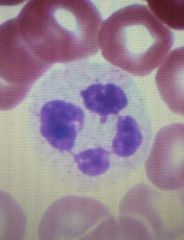
Name and function. |
Neutrophil Kill bacteria and first to injury site |
|
|
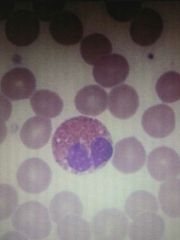
Name and function. |
Eosinophil Kills parasitic worms Helps to lessen body's response in an allergic reaction |
|
|
|
Orange-ish granules... |
Eosinophils |
|
|
|
Deep purple granules... |
Basophils |
|
|
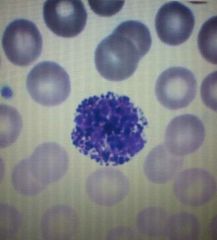
Name and function. |
Basophil Enhance inflammation Release histamine and heparin |
|
|
|
Make up less than 1% of circulating WBCs... |
Basophils |
|
|
|
Lymphocytes constitute _____ of WBCs. |
30% |
|
|
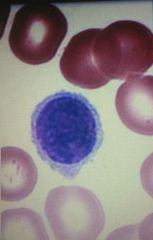
Name and function. |
Lymphocyte B cells- make antibodies T cells- control immune system; kill infected cells |
|
|
|
Monocytes make up ____ of circulating WBCs. |
6% |
|
|

Name and function. |
Monocytes Turn into macrophages |
|
|
|
Which WBC has an indented or C-shaped nucleus? |
Monocyte |
|
|
|
Which WBC has a round, purple nucleus? |
Lymphocyte |
|
|
|
Has bilobed nuclei and affects inflammation... |
Basophil |
|
|
|
Has bilobed nuclei and orange-ish granules... |
Eosinophils |
|
|
|
Multilobed nuclei, polymorphonuclear... |
Neutrophils |
|
|
|
Kills cancerous cells... |
T lymphocytes |
|
|
|
When not found in the blood, most leukocytes reside in... |
Lymphatic organs |
|
|
|
Which of the formed elements are the only "true" cells? |
Leukocytes |
|
|
|
Unique combinations of carbs, proteins and other chemicals that mark each cell are... |
Antigens |
|
|
|
If neither the A antigen or B antigen is present on the RBCs... |
Blood type O |
|
|
|
What type of antibodies does a person with Type O blood make? |
Anti-A antibodies Anti-B antibodies |
|
|
|
Does an Rh+ person have anti-D antibodies? |
No |
|
|
|
The clumping process of antigens is called... |
Agglutination |
|
|
|
Universal donor... |
Blood Type O |
|
|
|
Universal Recipient... |
Blood Type AB |
|
|
|
Does an individual with blood type AB have anti-A or anti-B antibodies? |
No |
|
|
|
The red portion of a hematocrit is... |
Packed RBCs |
|
|
|
The yellow portion of a hematocrit is... |
Plasma |
|
|
|
The Buffy coat consists of... |
WBCs Platelets |
|
|
|
The % of the total blood volume occupied by RBCs is the... |
Hematocrit |
|
|
|
The hematocrit provides an indication of the body's... |
Oxygen carrying ability |
|
|
|
Average hematocrit for males... |
49-56% |
|
|
|
Average hematocrit for females... |
42-46% |
|
|
|
A decrease in the body's oxygen carrying ability is called... |
Anemia |
|
|
|
Abnormally high RBC count, abnormally high hematocrit... |
Polycythemia |
|
|
|
Trace blood through the heart. |
SIC: RTRPPPLPLBLAA |
SIC: Ready To Race Perky Pet Pups Line Parallel Lanes Before Leaping And Accelerating |
|
|
What is an alternative name for neutrophils? |
Polymorphonuclear leukocytes |
|
|
|
What connective tissue is similar to basophils? |
Mast cells |
|
|
|
When will monocytes levels rise? |
When there is a chronic infection |
|
|
|
Platelet function... |
Hemostasis |
|
|
|
Define positive chemotaxis. |
Movement towards high concentration of a chemical |
|

